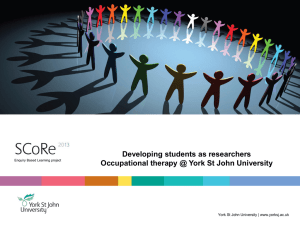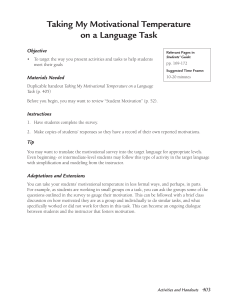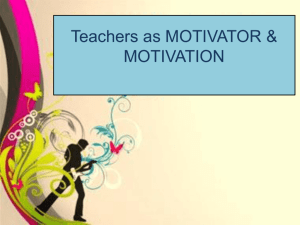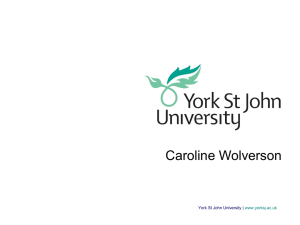Language Learning Motivation: Theories & Applications
advertisement
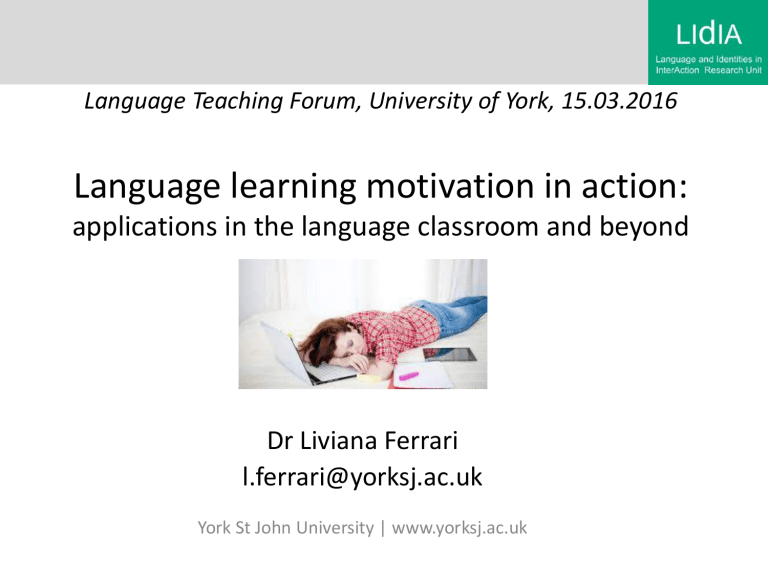
Language Teaching Forum, University of York, 15.03.2016 Language learning motivation in action: applications in the language classroom and beyond Dr Liviana Ferrari l.ferrari@yorksj.ac.uk York St John University | www.yorksj.ac.uk Aims of this session • To share ideas about L2 motivation based on our practice and experience • To shed light on some key theories of L2 motivation • To discuss how useful they can be to language learners and teachers in the language classroom and beyond York St John University | www.yorksj.ac.uk Overview • L2 motivation: what is it and why it matters • L2 in theory • L2 in practice York St John University | www.yorksj.ac.uk Activity In small groups, share your experiences, views, ideas with the help of the following questions: 1. What role does motivation play when learning a foreign language? 2. Are there differences between motivation before and during the learning journey? i.e.: what are some of the: • • key factors/reasons students choose to learn a language? key factors/reasons they stick with it, enjoy it, etc? 3. What fosters students’ L2 motivation/ engagement? (in the classroom and outside) York St John University | www.yorksj.ac.uk Defining Motivation • from the Latin motus ad ationem, lit. ‘movement towards action’ • a dynamic concept, which goes beyond simple intentions or reasons for acting or feeling a certain way • “motivation in learning is that compulsion which keeps a person within the learning situation and encourages them to learn” (Rogers & Horrocks, 2010, p.105) York St John University | www.yorksj.ac.uk Socio-Psychological Model (Gardner & Lamberts 1972; Gardner 1985 - CANADA) Integrativeness: desire for interaction and “emotional identification with another cultural group” (Gardner 2001: 5) Instrumental orientation: means-to-an-end, utilitarian motives York St John University | www.yorksj.ac.uk Cognitive & Educational Psychology theories (1980s-1990s) Self-determination theory (Deci & Ryan 1985) Intrinsic motivation: an inner drive, impulse, emotion, or desire that is derived from inner potentialities and latent resources. Extrinsic motivation: an inner drive, impulse, emotion, or desire that is derived from other people, or the real world. Intrinsically motivated activities are ones for which there is no “ apparent reward except the activity itself. People seem to engage in the activities for their own sake not because they lead to an extrinsic reward.” Deci (1975: 23) Cognitive & Educational Psychology theories (1980s-1990s) (cont.d) Attribution theory (Weiner 1986) Perception of past success and failure plays a vital role in shaping one’s L2 motivation. “It is generally believed that learners who attribute both success and failure to internal factors such as effort are most likely to maintain their motivation at a high level.” (Richards & Schmidt 2010: 39) Cognitive & Educational Psychology theories (1980s-1990s) (cont.d) Goal theories (e.g., Locke & Latham 1990) The higher the specificity and challenge of goals, the more effort individuals are going to put into achieving them. In other words, the vaguer and easier the goals are, the least effort and motivation is likely to go into pursuing those goals. “Goal salience” (Tremblay & Gardner 1995) represents the specificity of the learner’s goals and the frequency of goal-setting strategies used. Do ‘goals’ motivate language learners? Link to video clip L2 Self System (Dörnyei 2005; 2009) The Ideal L2 self : a strong vision of what it would be like to become a proficient L2 user should be a motivating drive to do what is necessary to achieve that goal, i.e. the Ideal L2 self. The Ought-to self concerns the qualities and required actions which language learners believe they ‘ought to’ possess or develop. A third, less explored element of this theory is the L2 Learning experience i.e., the situation or context where the learning takes place. Complex Dynamic Systems (CDS) (Larsen-Freeman and Cameron, 2008) CDS characteristics: Emergent Dynamic Non-linear Adaptive Feedback sensitive Context-dependent Attractor states Changing, but self-organising Factors in the system are interdependent https://commons.wikimedia.org/wiki/Commons:Featured_picture_candidates/image:Lor enz_attractor_yb.svg CDS theories have been applied to L2 motivation and SLA Directed Motivational Currents (DMC) (Dörnyei, Ibrahim & Muir, 2014) A 'Directed Motivational Current' (DMC) is an intense motivational drive which is capable of stimulating and supporting long-term behaviour, such as learning a language. Characteristics include: • Goal/vision-orientedness • Salient, facilitative structure • Positive emotionality • Participant’s ownership and directional control • might be described as being “in the zone” for a sustained period of time York St John University | www.yorksj.ac.uk Fiume (River) Model (Ferrari 2013) M factor 1 M factor 2 M factor 3 teacher group challenges & barriers Example 1 Graphics by C Bacilieri Graphics by Cinzia Bacilieri York St John University | www.yorksj.ac.uk Fiume (River) Model (Ferrari 2013) M factor 1 M factor 2 challenges & barriers learning situation Example 2 Graphics by C Bacilieri Graphics by Cinzia Bacilieri York St John University | www.yorksj.ac.uk Fiume (River) Model cont.d (Ferrari 2013) Possible applications: • Visual metaphor or heuristic device “ a concept or idea that is used, not so much because it is well-supported by the evidence, but because it helps us to think about the problem.” (SAGE Dictionary of Sociology, p.135, 2006) • Applicable to other teaching and learning contexts • Dialogue tool for teachers and learners • Fostering autonomy and reflection York St John University | www.yorksj.ac.uk Activity In small groups, discuss whether one or more of these theories/models could be useful to better explain and understand L2 motivation ‘in the real world’ of language teaching and learning. York St John University | www.yorksj.ac.uk References BYU Center for Teaching & Learning (2014). Learning motivation animation. Available at: https://www.youtube.com/watch?v=z8uEPA3OX5M (Accessed: 14 March 2016). Deci, E. L. (1975). Intrinsic motivation. New York: Plenum. Deci, E. L., & Ryan, R. M. (1985). Intrinsic motivation and self-determination in human behaviour. New York: Plenum. Dörnyei, Z. (2005). The psychology of the language learner. Mahwah, NJ: Lawrence Erlbaum. Dörnyei, Z. (2009). The L2 motivational self system. In Z. Dörnyei & E. Ushioda (Eds.), Motivation, language identity and the L2 self (pp. 9-42). Bristol: Multilingual Matters. Dörnyei, Z., Ibrahim, Z., & Muir, C. (2015). 'Directed Motivational Currents': Regulating complex dynamic systems through motivational surges,. In Z. Dörnyei, P. MacIntyre, & A. Henry (Eds.), Motivational dynamics in language learning (pp. 95105). Bristol: Multilingual Matters. Ferrari, L. (2013). The motivation of adult foreign language learners on an Italian beginners’ course: An exploratory, longitudinal study. University of York. Unpublished PhD Thesis. Gardner, R. C., & Lambert, W. C. (1972). Attitudes and motivation in second language learning. Rowley, MA: Newbury House. Gardner, R. C. (1985). Social psychology and second language learning: The role of attitudes and motivation. London: Edward Arnold. Larsen-Freeman, D., & Cameron, L. (2008). Complex systems and applied linguistics. Oxford: Oxford University Press. Locke, E. A., & Latham, G. P. (1990). A theory of goal setting & task performance. Englewood Cliffs, NJ: Prentice-Hall Inc. Rogers, A., & Horrocks, N. (2010). Teaching adults (4th ed.). Maidenhead: OUP. Tremblay, P. F., & Gardner, R. C. (1995). Expanding the motivation construct in language learning. The Modern Language Journal, 79(4), 505-518. Weiner, B. (1986). An attributional theory of achievement and emotion. New York: Springer-Verlag. Further reading Busse, V., & Walter, C. (2013). Foreign language learning motivation in higher education: A longitudinal study of motivational changes and their causes. The Modern Language Journal, 97(2), 435-456. Dörnyei, Z., Henry, A., & Muir, C. (2016). Motivational currents in language learning: Frameworks for focused interventions. New York: Routledge. Dörnyei. Z., MacIntyre, P., & Henry, A. (Eds.) (2015). Motivational dynamics in language learning. Bristol: Multilingual Matters. Dörnyei, Z., & Ushioda, E. (2011). Teaching and researching motivation (2nd ed.). Harlow: Longman. Lasagabaster, D., Doiz, A., Sierra, J.M. (2014). Motivation and Foreign Language Learning: From theory to practice. Amsterdam: John Benjamins.
